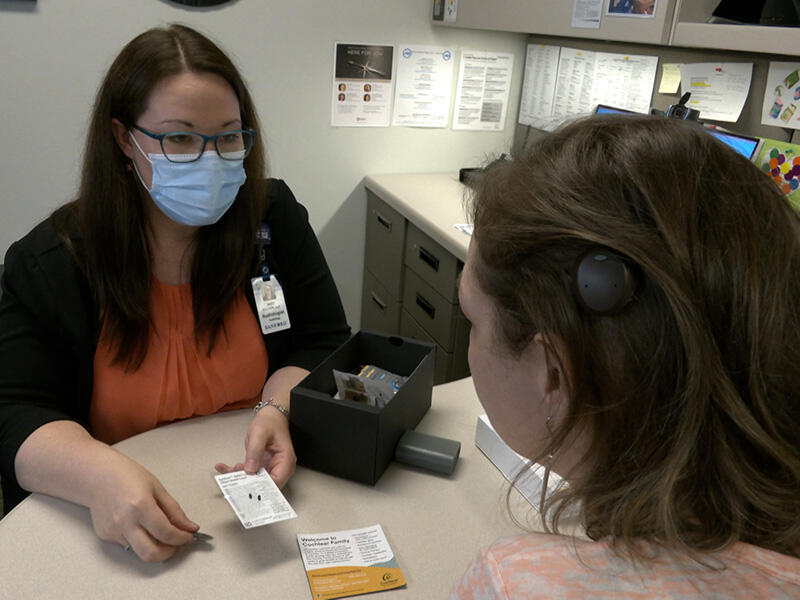At the audiology office inside Sanford Health’s Detroit Lakes Clinic, Melissa Duke is about to try out her new sound processor for the very first time. Duke has had hearing issues for most of her life.
A history of hearing issues
“It goes way back to when I was about three or four,” said Duke. My parents started noticing that I’d say ‘What?’ or just not respond a lot more than my older siblings.”
She first had tubes put in her ears as a child to help drain the constant infections. In middle school, surgery was required, and the scar tissue eventually caused some hearing loss.
Hear your best: Audiology at Sanford Health
Still, Duke managed to live with it as best she could. She works at Sanford Bemidji, and the pandemic made her hearing problems more difficult to ignore.
“It really got to me, because that was around when COVID hit and I was doing reception. So the masks came, Plexiglas came, and I was really good at hiding the fact that I couldn’t hear. When that started happening, it really affected me. I’d actually have to get up and leave because, you know, I couldn’t hear them,” said Duke. “I’d have to have them repeat themselves and it would frustrate the patient. I would get frustrated and just kind of down. That was really hard.”
Audible options
After years of hearing loss and pain from ear infections, Duke went to Fargo and neurotologist, Dr. Michael Shinners, who would eventually perform two surgeries.
“There’s a certain type of surgery, a type of mastoidectomy, where we remove some of the bone behind your ear where you actually need to make the opening to the ear bigger so that you can clean their ear long term,” said Dr. Shinners. “The negative of that is it can make it hard to wear a hearing aid because the opening is bigger and it just doesn’t fit well, or the sound escapes and it just doesn’t work well.”
That’s what happened with Duke. Her ear infections went away, but when hearing aids didn’t work for her, Dr. Shinners provided one more option: a bone conduction implant.
“She has relatively decent hearing for her inner ear and that’s why we’re still able to use it via bone conduction,” said Dr. Shinners.
At the audiology offices, Duke tested her device. The implant is attached to her skull, under the skin. Outside of her skin, a sound receiver connects via magnet to the implant.
“The processor that we program today sits on the outside of the head, but what Dr. Shinners had put in and what that’s communicating to is the implant part that’s underneath that,” said Mary Richter, doctor of audiology at Sanford Detroit Lakes. “What that actually does is vibrates the implant portion, and that’s what gets that sound down into her inner ear.”
This receiver not only helps Duke hear better, but amazingly, it can be used with Bluetooth devices as well, allowing her to connect it to her phone or other devices. On her first day, she noticed some other advantages over her hearing aid too.
“The sound is much better than I thought it would be,” said Duke. “And I’m not really getting much outside. I’m not getting little things like paper crinkling. That was a big thing. When I wear my hearing aid, you can hear that paper crinkle or anything little, and it would kind of bother me, but I’m not hearing that.”
The future sounds great
Day one with her new hearing system has been a success, but Duke has plenty more to look forward to. She’s an avid concert-goer who says she can’t wait to hear what live music sounds like. She’s excited to take phone calls directly into her device too.
But most importantly, she can’t wait to feel more comfortable in her surroundings.
“I hid it for a long time and a lot of people didn’t know I was hard of hearing. Only when certain situations came up, I would let people know,” said Duke.
“I don’t have to really worry about that anymore. I’m not gonna be missing anything. In conversation sometimes I only heard bits and pieces and I’d have to try and put it together because I didn’t hear a word. So I’m hoping I won’t have that. And I don’t think I will. ‘Cause I’ve heard every single word.”
Learn more
- Hearing loss, hearing aids and preventing further damage
- Audiology patient notices ‘night-and-day’ hearing difference
- Ear protection is vital: From lawn mowing to hunting
…
Posted In Bemidji, Brain & Spine, Detroit Lakes, Ear, Nose & Throat, Fargo

